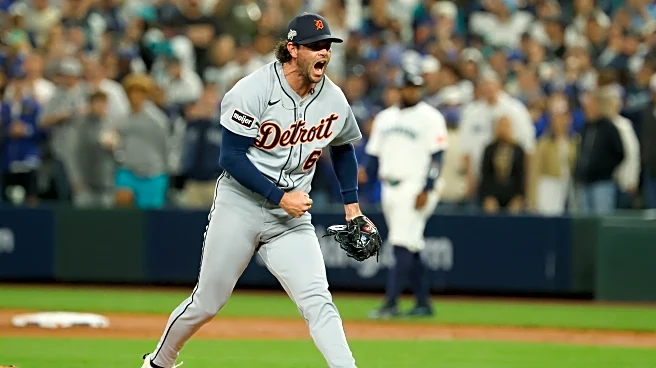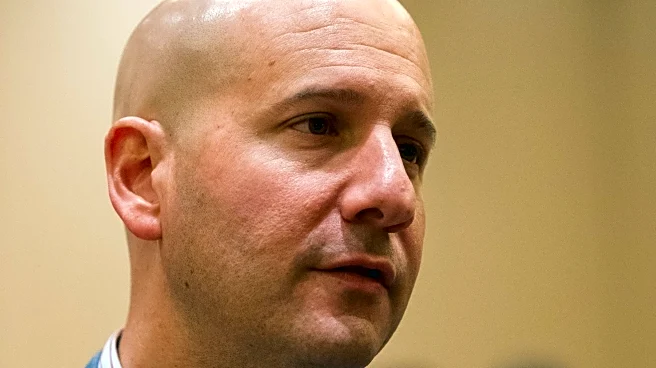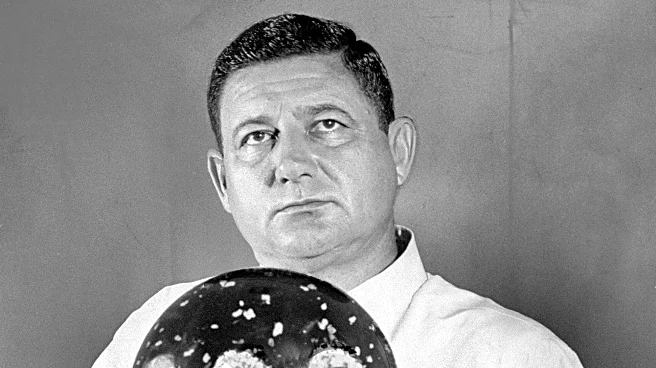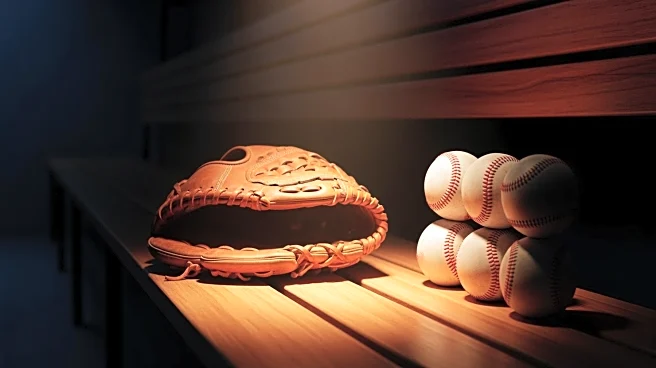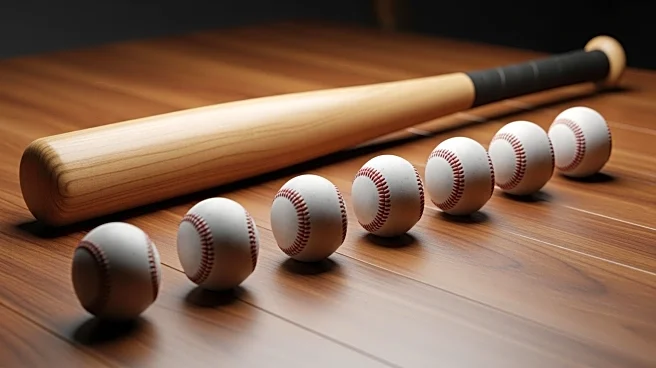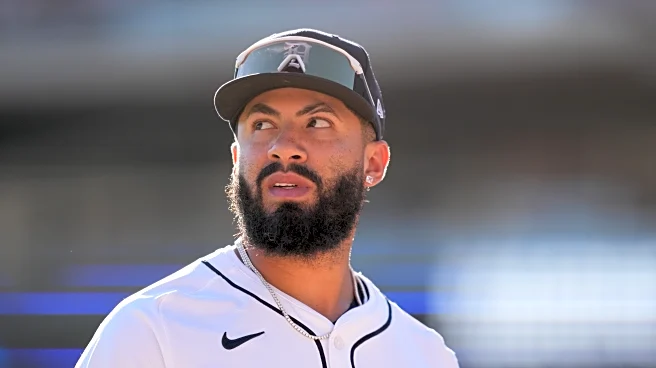It’s a good idea to know what you’ve got before going out shopping. With that in mind, let’s try to assess what the Detroit Tigers can reasonably expect their farm system to produce in 2026 before we get into free agents and trade ideas this offseason. We’ll start with position players and follow up with pitchers in a separate article.
Overall, the Tigers’ system is a bit of a lopsided cupboard at this point. The pitching side doesn’t offer a whole lot of obvious answers, while the Tigers have some
top shelf position players they can look forward to debuting next season. They also have a group of prospects and former prospects who have thus far stalled out at the Triple-A level. There’s still a chance of a breakout there, while others could potentially be flipped in trade along the way.
This is a really exciting time for the system. When Riley Greene and Spencer Torkelson arrived in 2022, the team was pulling out of one of the worst half decades in franchise history. Now the Tigers are coming off back-to-back postseasons and Wild Card round victories, and they have three of the top hitting prospects in baseball bearing down on the major leagues. It remains to be seen how much impact Kevin McGonigle and Max Clark will have on the 2026 season, but they’re both on track to be very good additions. Beyond them there is still quite a bit of positional talent coming. It’s just more questionable as to who really has a legit chance of contributing in 2026.
So while the Tigers appear to be running back basically the same positional group in 2026, there is a good chance that they’re going to get plenty of help as the season unfolds.
Kevin McGonigle
Obviously, the number one name on the list is top prospect Kevin McGonigle. Fresh off of tearing up Double-A pitching in his age 20 season, the rising star, ranked 1 or 2 among the game’s best prospects, is currently beating up on Arizona Fall League pitching and getting some reps at third base despite playing shortstop all season long for the Erie SeaWolves. He’s the stand out name, but he’s certainly not alone in the system either.
McGonigle doesn’t have Riley Greene’s power, but he is an even more precocious pure hitter, controlling the strike zone very well and rarely swinging and missing. His above average raw power is going to play, because McGonigle is already great at driving the ball on a line and in the air to the pull field. We’re probably not talking a 30+ home runs per season type of hitter, but one who should consistently hit for average, live on base, and contribute plenty of 25-30 home run seasons.
As things stand, you don’t really love McGonigle at shortstop. His arm strength is a bit lacking to go deep in the hole and make the toughest throws, and his overall range is pretty average by major league standards. In short, he’s just solid, but without that standout tool, such as freakishly good hands or arm strength. This hasn’t hurt him much in the minor leagues, but his tendency to overcompensate sometimes makes him error prone.
On the other hand, he’s missed over a month in each of his first two pro seasons due to injury, and just turned 21 years old. There’s time to mature and play a more measured brand of defense that could make him an acceptable defender at shortstop. If his defense ian’t an upgrade from Trey Sweeney’s, you can probably live with it for a little while as top shortstop prospect Bryce Rainer develops. McGonigle’s bat is going to make up for a fringy defensive profile at the shortstop position.
The Tigers might believe that McGonigle needs some time at the Triple-A level next spring, but the fact that they sent him out to the Arizona Fall League just to get reps against worse pitching than he saw at the Double-A level makes me think he’s highly likely to be in the mix with a strong spring camp. There isn’t a whole lot of point to it otherwise, as even his work at third base has been fairly sporadic. He only started there 2-3 times a week over a roughly five-week Fall League schedule, so it’s not like it was a full court press to teach him a new position. They’re just getting him extra reps where they can, and to me that speaks to their interest in taking him north next spring if he has a strong camp.
There is also the added incentive of the prospect promotion incentive. Should they call him up on Opening Day, McGonigle is going to immediately become the early favorite for Rookie of the Year. Should he win it, the Tigers would be awarded an extra comp pick between the first and second rounds. Picks at that level are pretty valuable, as evidenced by the fact that McGonigle himself was a competitive balance round A selection back in 2023.
Unless something really goes awry in spring camp, I think the odds that McGonigle is with the Tigers on Opening Day are pretty high. If he’s willing to sign a team friendly extension like Colt Keith did, then he’s a lock, though that would negate the PPI pick scenario. Of all the Tigers prospects, he’s the one close to becoming an impact hitter at the major league level in the immediate future.
Max Clark
A big plus for Clark this season was displaying more of his developing power potential. His bat to ball skills, plate discipline, and pitch recognition all advanced very nicely but weren’t much in question to begin with. Combined with sustained batspeed work, Clark started ripping the ball to right field more often and driving good fastballs in the air even as he saw a signfiicant improvement in competition from July’s move to the Double-A level on to the end of the season. Overall he looked like a much more physical, impactful hitter and his very good K-BB numbers and power traveled consistently from High-A to Double-A. Combine that offensive potential with a defensive game that also continued to improve this season and you have a very exciting young prospect.
Clark struck out just 16.7 percent of the time and walked 14.3 percent of the time in his 43 games in Double-A. Those aren’t far off of McGonigle’s marks. Clark hit seven homers, five doubles, and three triples with seven stolen bases as well. His numbers weren’t huge, as his work to pull the ball in the air more started to get exploited for more weak contact, but he lived on base and put up consistently good at-bats en route to a 135 wRC+.
He struggled with lefties a little once he made that jump, and Double-A is where the quality and frequency of left-handed pitchers with control starts to become a major test. But overall he did improve against same-side pitching over the course of the season and that was another promising trajectory in his game. He has the skills to continue handling better and better pitching and I’m not particularly concerned with his splits any longer. We’ve seen his ability to spray the ball sharply the opposite way. Working to capitalize on what looks like average power potential now is the wise move.
It’s an impressive package of developing skills for a player who can’t take a legal drink for another few weeks. The Tigers will have a star player if he can ultimately put it all together, but I also think he needs more seasoning at the plate and time to develop than McGonigle does. His ETA is probably more toward the second half of the year assuming he takes another step forward next spring.
Clark doesn’t quite have McGonigle’s upside as a hitter but the overall package with his speed and defense added in could make him the more valuable player of the two in time. He’ll probably move more slowly, and it would be no surprise to see him start the year in Double-A while the Tigers try out some center field depth at the Triple-A level. But when Clark does push his way to Toledo he’ll immediately become an option as an injury replacement, and the Tigers will probably want him in Detroit full-time at some point unless Parker Meadows’ work at the plate turns around radically.
Hao-Yu Lee
If there’s one upper level prospect in the Tigers’ system who is getting a bit overlooked at this point, it’s probably 22-year-old infielder Hao-Yu Lee. Part of the problem is the redundancy of infielders who play second and third base with a bat-first profile, but haven’t figured out how to get their power more consistently. There also isn’t a whole lot of playing time likely to be available at those positions with the big league club, at least not in 2026.
The Tigers will presumably stick with Jahmai Jones as their lefty masher du jour. However, they certainly could move on from Andy Ibáñez, so there may be some playing time for a right-handed hitting infielder, just not a lot unless someone really breaks through. Lee is going to have to leverage his power a little more and continue to clean up his defense to win that playing time should it become available.
Lee quickly went down with an injury after coming over from the Philies in exchange for Michael Lorenzen at the July 2023 trade deadline. He then tore up the Double-A level pretty well as a 21-year-old in 2024, putting up a 143 wRC+ with pretty good strikeout and walk numbers. His first Triple-A campaign this year saw muted power numbers but a solid overall approach and a .342 on-base percentage, with 14 home runs in 126 games.
Lee will take his walks, but he’s still an aggressive hitter and has a tendency to get caught out front on good breaking and offspeed stuff. He handles velocity well and is a good fastball hitter overall. He does a lot more damage on fourseamers, but he also tends to pop up good riding fourseamers as well. Still, you’re not getting many fastballs of any type in the zone without Lee putting the barrel on the baseball. His problem is still too much vulnerability to good secondary stuff, where that aggressiveness becomes a weakness, particularly against right-handed pitchers with good sliders.
Of course, if he didn’t have some weaknesses he’d be a top 100 prospect. In Lee’s favor is youth, early experience in the upper levels, and a bulldog mentality than his managers love, most of the time. He does damage against left-handed pitching, and there may be a path to a limited role in the majors as a specialist off the bench. He’s never going to be a defensive asset at second or third base, but if he matures a little more he won’t hurt you in either position. Still, a lot will have to go right to see a major breakthrough into an everyday player here.
Max Anderson
Max Anderson remains a name on many lips this fall, and he tore apart Arizona Fall League pitching as impressively as McGonigle did over the last five weeks. Still, Anderson has already seen 32 games worth of Triple-A pitching, where he struggled, and the AFL caliber is well below that level. Like McGonigle, it’s hard to really impress when you’re facing lesser competition, and the only thing notable would have been if one of the pair had trouble out there.
Anderson started to hit the ball in the air and to the pull field more often this season, without sacrificing too much in terms of strikeout rate. The more he can wait for pitches he can drive in the air, the closer he’s going to be to avoiding the fate of someone like Justice Bigbie, who hits the ball hard consistently, but too often on the ground to ever break through at the major league level. The issue is that while Anderson has pretty good bat-to-ball skills, he will swing at anything close even ahead in the count and often gets himself out on pitcher’s pitches. A more mature approach is necessary to really crack the major league level and his strikeouts and walks trended pretty poorly when he got to Toledo.
As a defender Anderson should be close to average at second base. His arm is stretched at third but he looked decent there in the few Fall Leagues looks I had of him at the position. He’s not going to provide any surplus value defensively or on the bases, so as with Lee he’s really got to unlock more of the plentiful raw power in his bat to break out into a MLB regular, or at least learn to take his walks and post consistently strong on-base percentages.
There’s a reason no one was giving up a good reliever for him at the trade deadline, but while he’s a year older than Hao-Yu Lee, Anderson really trended in the right direction in conquering the Double-A level. If Anderson can continue on that trajectory next season he’ll get a look at the major leagues too.
Between Lee and Anderson though, you’d really like to convert one of them in trade into a player that might be more useful to the Tigers proper. Max Anderson had a lot of eyes on him in the AFL, and that showcase might make him the more valuable to the two right now. Of course, trading non-top 100 infield prospects doesn’t tend to get you too far in the offseason either. With a rapidly deepening 40-man roster, the Tigers might decide to keep both and try to move on from one of the next two on our list of players to watch.
Justyn-Henry Malloy
Justyn-Henry Malloy has graduated from prospect status, but there’s still some chance he finally breaks out offensively. To get there, he still needs to become at least a little more adept at handling major league quality breaking stuff. He’s an excellent fastball hitter with top shelf zone discipline, but hasn’t been able to take the next step to force major league pitchers to challenge him with more heaters. And because he’s mediocre at best as a corner outfielder and first baseman, the bat really is going to have to play for him to have a significant major league career.
He’ll be 26 in February, and because his profile is entirely bat driven it’s hard to expect a major breakout at this point. Malloy has put up good numbers against left-handed pitching at the major league level, but mainly just by walking a ton. He’s got to start doing a lot more damage. If he ended up in some kind of a trade this offseason it would only be surprising because he was the first player Scott Harris traded for when he arrived in Detroit, and he’s not worth a whole lot at the moment. If he were exposed to the Rule 5 draft he’d absolutely be claimed, but there isn’t going to be tons of interest on the trade market either. Still, where he isn’t of much use, is on the Tigers 40-man roster right now. We’ll see if they hang in there with him another year or now.
Jace Jung
Jung is a year younger than Malloy, but he’s into a similar state of post-prospect limbo now at 25. He has some power, but has shown zero ability to get to it against major league pitching. He’s a mediocre infielder, he runs poorly, and his one standout trait is his ability to draw a lot of walks. There isn’t much meat on the bone for a team to come calling on a trade, but there’s also little path to major league playing time even if he rebounds somewhat at the plate and starts to cut down the strikeouts and do some damage.
As with Malloy, keeping a player like Jung on the 40-man roster for another year hoping for a major breaktrhough seems like a poor idea. Seemingly, the Tigers will need a spot at some point and it’s probably time to move on from one of them this offseason even if they’d like to hang onto them both for one more year. And as with Malloy, it’s hard to imagine getting a whole in trade, but the Tigers might find a deal for someone who fits their 40-man roster better.
Josue Briceño
Like McGonigle and Clark, this recently turned 21-year-old hit his way through High-A to Double-A this season and cracked 20 homers in 442 plate appearances. He struggled some once he got to Erie, as his strikeout rate jumped and he popped up a few too many balls. Still his swinging strike rate was lower than Max Anderson’s and he just took too many close pitches that didn’t go his way combined with a pretty poor run of batted ball luck considering how hard he is consistently hitting the baseball. He will be happier when he gets to Toledo and has the ABS challenge system on his side.
It’s been a pretty astonishing run for Briceño. After tearing up his knee in Single-A Lakeland early in the 2024 season, he took the opportunity to get leaner and stronger, and some work with the Tigers to get his legs engaged in his swing more paid huge dividends. He had barely turned 21 and only had 51 games above Complex League ball when he destroyed the Arizona Fall League and took home the first of back-to-back MVP titles for the Tigers system a year ago.
The only reason he’s less likely than Anderson or Clark to be a factor in 2026 is the fact that he’s still catching and needs to keep working on his blocking and throwing mechanics. The bat has the potential to be the most impactful in the whole system, including McGonigle’s.
We’ll see how long the Tigers continue developing him as a catcher. He’ll start the year back in Double-A, but it’s entirely possible he hits his way to the majors and the Tigers put catching duties on the backburner and use him as a DH/1B for now instead.
Thayron Liranzo
Liranzo might be more likely to end up a backup catcher than Briceño, but there are differing opinions on that score. The reason I have him pretty far down the list is that his bat is clearly the furthest from getting him to the major leagues. The switch-hitting catcher is still young, and his raw power and plate discipline are very intriguing, but he’s got a lot further to go in terms of handling top shelf stuff. Expect him to repeat Double-A in his age 23 season and work on his complete game there most of the year. Liranzo has been on a pretty swift development curve so far, and it’s entirely reasonable that it might take him more time to become a major league option. Still, he’s on the 40-man roster as of Tuesday, while Briceño is not, so a look at the big leagues next year isn’t out of the question.
Wild Cards
Two more prospects emerged a bit in 2025, going from fringe prospects to intriguing 40-man roster decisions. Trei Cruz polished his all around game to the point of looking like a viable major league utillityman, while first baseman/catcher Eduardo Valencia erupted with the bat in his first look at the Triple-A level.
The Tigers ultimately decided to protect them both from the Rule 5 draft, so it’s a safe bet they have a role in mind for them. It may just be depth at the Triple-A level, and it’s possibly one of them could be part of a trade by the time Opening Day rolls around. Still they give the Tigers a very versatle utility player who can handle center field and shortstop, and a right-handed bat with power in Valencia who could spell Spencer Torkelson at first in case of an injury and maybe, just maybe hit enough to fill in should the Tigers need a little catching help along the way.
Finally, catcher Tomas Nido has been retained to serve as the Tigers first catching option at the Triple-A level. The veteran minor leaguer is perfect for the role. He has the defensive skills the Tigers emphasize, and did a nice job spelling Jake Rogers early in the 2025 season.
The Tigers offense will have some support in 2026
You’re not going to find a farm system with more to offer in terms of position players right now, and the three main ones are all moving rapidly toward their major league debuts. McGonigle, Clark, and Briceño are three of the 20 best hitting prospects in baseball in my opinion. They also have the potential to balance out the prevalance of hitters in the Tigers’ lineup who hit for power but strike out quite a lot. There’s a good deal of depth behind them too.
So, while the Tigers may end up running back much the same roster as in 2025, there is a lot to look forward to from the farm. Contributions from some of these players will almost certainly be a signficant factor. Whether it’s enough to take advantage of what appears to be Tarik Skubal’s final season in Detroit remains to be seen. One thing Scott Harris and his front office have done well is draft position players, and those guys are now very close to making an impact. It will be very interesting to see the next wave try to break through to the major leagues in 2026.



